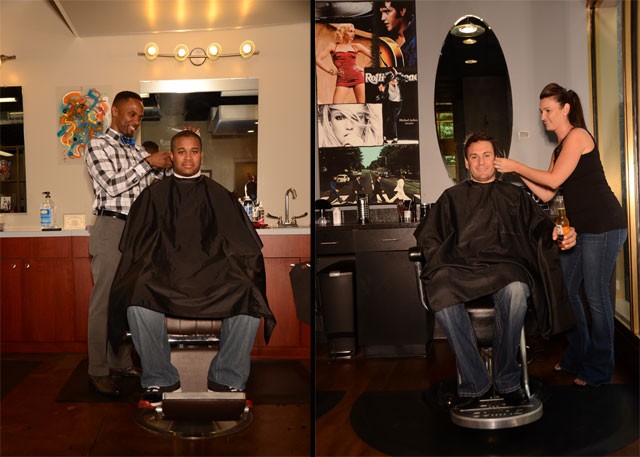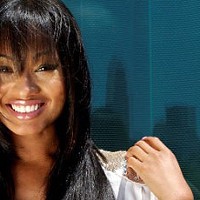Inside Charlotte's barbershop culture
Traditional versus contemporary, no-frills versus luxe — where a man gets his hair cut says a lot.
By Jarvis HollidayIt's a mild Friday evening in Uptown. East Trade Street is bustling, from the transit center to the EpiCentre to the Ritz-Carlton and all points surrounding. The traffic of well-dressed men and women through the front entrance of one business appears to be building momentum. They pass a small, street-front patio where a few guys have congregated and are smoking cigars. R&B music blares from a speaker mounted on the facade.
Inside, that same music can be heard, though it plays a little softer — the low hum of conversation is more audible. Close to 50 people, mostly African Americans, are gathered, their ages ranging from about 28 to 45. Several of the men are wearing bow ties — it's part of the evening's theme — and most of the women are adorned in stylish dresses and high heels.
Numerous paintings from a local artist are on display around the main room (the artist would later address the crowd). A billiards table goes unused at the moment; a flat-screen TV is tuned to A&E, but the volume is muted. In an adjoining room, there's complimentary food — wings, meatballs, deviled eggs and the like — spread out on a table, and next to it is a glass beverage dispenser filled with a green cocktail.
There's quite a social atmosphere bubbling inside this barbershop. Yes, you read that correctly: barbershop. In fact, three or four barbers are cutting the hair of clients amid this festive scene at No Grease Exclusive Male Grooming. While the gathering isn't an every-Friday occurrence here, it is one of several special events hosted at No Grease throughout the year. More importantly, it represents how evolved the barbershop experience has become. Or has it?
Men in Charlotte have a varied list of places where they can get their hair cut. The choices can be easily categorized as the traditional barbershops (no-frills shops run by older men who've cut generations of the same family), trendy barbershops (stylish and oftentimes themed décor), franchises (the ubiquitous Great Clips) and the high-end shops, which are commonly referred to as men's grooming lounges. A decade after the term "metrosexual" began its ascension and subsequent dominance in mainstream vocabularies, not only is the word now passé, but the characteristics of the modern male — a man who dresses really well and pays extra attention to his grooming, i.e., gets manicures — are much more accepted.
Today, many men want more than a good haircut and shave, but there are still plenty who desire only that from their barbershop. As a result, there's an old-school barbershop culture that finds itself pitted against the new-school — that is, traditional versus contemporary and the weight of the importance of socializing (the infamous shop talk) or social status (name-dropping your shop). Yet, as complex as those dynamics are, they exist against a backdrop that's long been a part of barbershops: the manifestation of class, race and gender. In 2013, where a man gets his hair cut in Charlotte says as much, if not more, about him as how he gets it cut.
CLEANS UP NICE
Emerson Joseph was a trailblazer when it opened in Uptown in 2005 as Charlotte's first upscale men's grooming lounge. The first floor of the historic building at 221 S. Tryon St. was transformed into a barbershop, salon, spa, lounge and all-around cool spot for men; it also features shoe shine, wardrobe consultation (a tailor), membership options and more. Zachary Edwards recalls having dinner on the patio of Ruth's Chris Steak House one evening several years ago and witnessing a members event taking place across the street at Emerson Joseph. A bunch of exotic cars, brought in especially for the event, lined the street in front of the shop. A good-looking crowd of people had made their way inside.
"I remember thinking, 'That is the coolest place on the planet. I want to be at that party right now,'" Edwards says. Soon after, he would become a frequent client at Emerson Joseph, and, he says, it changed how he viewed getting haircuts.
"I used to dread getting my hair cut, going to just a hair salon, or wherever, a Great Clips, even a barbershop. It wasn't one of those things that you'd go out of your way and get excited about going to do. But with this place, I always found as a customer that I looked forward to coming here."
He liked Emerson Joseph so much that in 2011, he looked into purchasing the business. Edwards knew that the owner, then-Charlotte real estate developer Jim Donnelly, was looking to sell. After some extended negotiations, Edwards says, he and his business partner bought Emerson Joseph that fall in a deal that also included the building it's housed in and the shop's Ballantyne location, which had opened in 2007.
Some might say Emerson Joseph ushered in a new approach to the men's barbershop in Charlotte. (A full-service cut starts at $39 — not exactly budget-friendly.) Or it could be that it was the first to launch in a new wave of what modern men desired in personal grooming. For example, there are now three Roosters Men's Grooming Center locations, an upscale grooming salon chain, in the area (south Charlotte, Ballantyne and Lake Norman).
When identical twins Damian and Jermaine Johnson opened No Grease Exclusive in 2009 at Time Warner Cable Arena, they were staking their claim to a piece of the large market of professionals and executives who work (and the increasing number who live) in Uptown. The No Grease brand is well-recognized throughout the city, established when the Johnsons opened their first barbershop in 1997. Though they've had shops close in the past due to location issues (such as the decline and subsequent closing of Eastland Mall), they currently have what is arguably their best lineup to date: the aforementioned Uptown location, No Grease Unlimited at Concord Mills mall, and their newest addition, No Grease Mosaic, which opened in April at Johnson C. Smith University's Mosaic Village on West Trade Street, near the college campus. The brothers also operate a barber school in Plaza Midwood.
Each of No Grease's three shops has its own identity by virtue of its location. For example, No Grease Mosaic draws the college crowd, many of whom live in the apartments of Mosaic Village. And the brothers have been strategic in each store's layout, décor and services. There isn't, however, a lot of diversity in the race of customers who frequent these places — though the Concord Mills location does draw a larger segment of non-black clients. But this is common in barbershops in Charlotte as it is around the country.
Simply put, there are black barbershops and white barbershops.
"White church, black church — it's the same thing," says Damian Johnson, drawing parallels to the de facto segregation. "The culture piece of doing hair can never be denied. People want to feel like you understand their culture, that you understand their background."
Johnson points out that black barbers have a deep history in this country, dating back to slavery, when they cut the hair of their white owners and the families on the plantation. Black men continued to be the nation's primary barbers through the early 1900s, and from there were able to establish barbershops as viable, independent businesses in their segregated neighborhoods.
The racial history of the industry is one of the leading reasons why today, at most black barbershops, the majority of the barbers are black men, while at most predominantly white barbershops/men's salons, white women often make up a significant portion of the staff (based on the shop owners we spoke with for this story). The main difference between a barber and stylist is a barber primarily cuts, shaves and trims, and it's most often shorter hair, while a stylist might work with longer hair and often provides coloring and other cosmetic services. The terms, however, are used interchangeably.
SHE WILL SEE YOU NOW
There are about 10 stylists between Emerson Joseph's two locations, and only one of them is male. Edwards, the owner, says even though all of his clients are male, many of them seem to like the aspect of his nearly all-female staff.
"The hiring-women thing is more of a function of the business," he says. "When you look at the numbers and who's the most productive, it's the pretty girls ... I think that's part of the [appeal] — being catered to by pretty girls."
Christopher Soto became a client at Emerson Joseph about two years ago. A New Jersey native, he says he grew up going to an "old-school barbershop, just real old-school. That barbershop where you have the older people, the younger people, the selling of DVDs. The fade is probably the No. 1 cut they do."
Soto, 27, says he changed the way he wears his hair a couple of years ago, and that's what prompted him to go to a place that offered more of a salon style. After choosing Emerson Joseph, he's now spoiled.
"Every time I get a haircut, I always take advantage of the hand detail and hot towel," Soto says. "Every other time [I go], depending on how I'm dressed that day, I get the shoe shine."
As for those pretty girls working there?
"What's nice about Emerson Joseph is that they get stylists who are good with their craft but they also look good," he says. "I think for the majority of the people, having a pretty woman give you a haircut is an added bonus."
Women run men's barbershops, too. When Jill Matthews and her husband moved to Charlotte in 2009, she had plans of opening her own barbershop. By that time, she had nearly a decade of experience as a licensed barber. And she knew she wanted to do things differently from what she'd been accustomed to.
"My experience was actually in those token barbershops, where literally your classic older man owned it — a two- or three-chair shop," Matthews says. "That's how I got started, and those were the kind of places I was working. The money was good, but the atmosphere wasn't what I was desiring to work in. It was always really old shops, so not anything fancy."
Matthews began putting together the concept of the type of barbershop she wanted to open. She felt that Uptown would be the best location for it and she connected with a realtor who found a space that had recently become available on the first floor of the 121 West Trade building. When they told the leasing agent that Matthews wanted to open a rock 'n' roll-themed barbershop, with a waiting area that would resemble a bar, the idea was met with some hesitation.
"That's a classy building," Matthews says. "They're really particular on what type of industry even goes into their commercial space." The prestigious Charlotte City Club, for example, occupies the building's top two floors.
After Matthews had some blueprints and sketches drawn up of her vision, she was able to convince the building's operator that her business would be a suitable tenant. The Cut Barbershop officially opened its doors in March 2010.
On a recent Wednesday, around 5:45 p.m., four barbers and a receptionist man their stations inside The Cut. Well, not man, per se — the staff is all women. Three of the barbers are cutting heads; the fourth is sitting in her chair awaiting her next client. The receptionist's stand is enclosed in a bar counter, complete with bar stools. Clients can enjoy a beer while they wait.
Across from the bar is a more standard waiting area; it's posh, with black leather couches and a large flat-screen TV tuned to SportsCenter. Early-2000s rock music playing on the house speakers provides the soundtrack.
By 6 p.m., four more clients have arrived, in what appears to be a bit of an after-work rush. Of the eight or so guys in here, half are dressed professionally (think ties, some recently removed, and button-downs) and half are dressed more comfortably (shorts, jeans, flip-flops).
Aside from the music, there isn't much other noise in the waiting area. The clients flip through magazines or surf the Web on their phones, essentially keeping to themselves.
The atmosphere begs the question: Where's the shop talk that men typically engage in?
"I think there's definitely a difference," Matthews says. "If there was an all-male staff in there, oh my gosh, the conversations would be completely different. I actually really encourage our girls to build relationships with their clients... You'd be surprised how many times, even though we're women, we're cutting it up with the guys in there, our clients. To an appropriate extent, we still do have that shop talk. But it is different."
Matthews concedes that The Cut lacks that "male-on-male camaraderie," but says that her clients are drawn to her barbershop because of the overall atmosphere, convenience, and price point — haircuts start at $20, a bargain considering its Uptown location and amenities. And, she says, "one thing I pride our shop on is the amount of experience the people working in there have. ... The talent we have in there is tremendous." They must be doing something right; a year and a half after The Cut opened, it was profiled in The Big Black Book, the coveted style manual for men, published twice a year by Esquire magazine.
TALK THAT TALK
Ken Brown started going to B&J Barber Stylist Shop, located in a small plaza at 2200 Beatties Ford Road, about four years ago. He was drawn to it largely because it resembled the kind of barbershop he was accustomed to growing up in the small town of Clarkton, N.C. "An older type barbershop ... people have been going there for years, and you see kids coming back from college who say they've been going there since [they were] little," is how he describes his hometown shop. He found that atmosphere in Charlotte at B&J. He also found another all-important element: shop talk.
"What we usually talk about is sports, what's going on in news at that time," says Brown, 29. "The best part to me is going to the barbershop and hearing all the wrong information. That's where you're going to hear it. People have the wrong information, have their facts backwards. I've even been guilty of that myself, but it always adds some fun to it. You never want to take your barbershop information somewhere else; just keep it there because you don't know if it's right or wrong."
Joseph Grimes, a veteran barber, opened B&J in 1992 after relocating from Raleigh. Last fall, he celebrated his shop's 20th anniversary with a community day event featuring $5 haircuts and free food. It's not easy to name many other barbershops in Charlotte that have been in business for two decades. Grimes says one of the keys to his success has been providing a family-friendly environment. But he does acknowledge that boys will be boys.
"A lot of the things we talk about in the barbershop, in school they teach us that we shouldn't talk about," Grimes says. "But that's what makes it interesting; everybody is not the same. A barbershop should be a place where you can go and voice your opinion. We can talk about politics, we can talk about sports, we can talk about women, but all of it should be done respectfully."
At any of the three No Grease locations, you're almost guaranteed to witness barbers and clients, both in the chairs as well as those waiting, engrossed in discussions. On one Saturday afternoon at No Grease Mosaic, the conversations ranged from the evaluation of Stevie J's womanizing on reality TV show Love & Hip Hop Atlanta to what teams are going to play in next year's Super Bowl (though the season hasn't even begun yet).
"When you have a male[-staffed] barbershop, there's a hidden code of organized chaos going on with the conversations, with the lingo that you're using," says Damian Johnson, co-owner of No Grease.
THE NEW OLD
Throughout the years, No Grease has been quick to embrace change and new trends in the industry. Johnson points out that, to meet the needs of many of their clients, they offer appointments, which is not common at many black-owned barbershops. A compelling website and strong presence on social media, particularly Facebook, is also essential to the business, whereas in the past, he says, most barbershops like his relied on word of mouth. Despite the recent trends however, he says barbershops are returning to some of their classic attributes.
"The barbering business has evolved, and it has declined, and then it's evolving again," Johnson says." I think now, hopefully what we'll see is the tradition of barbering being the original social network coming back into relevance. The hair industry has always been that place of networking, connecting people and being that community leader, being that voice for the people ... I think it's getting back to that in some respects, but it's still growing to that place."
The nostalgia is also in the services themselves.
At Emerson Joseph, a man can get a haircut, manicure, pedicure, massage, be custom-fitted for a suit, play pool and drink beer all in one visit if he'd like. That may be a bit much — though Edwards, the owner, says they do have a member who splurges on himself to a similar degree about once a month. This clearly isn't your grandfather's barbershop. But gramps would probably be pleased with at least one menu item.
"We do the old-fashioned straight-razor shaves, which just feels iconic when you get one," Edwards says. "Sitting in the chair — I always imagine that this is like my grandfather getting straight-shaved."
It was also important to Matthews to incorporate elements of the traditional barbershop when she was conceptualizing The Cut, even if the surface appeal was already enough to hook clients.
"I came up with the concept of beer, sports and rock 'n' roll. What guy doesn't like any one of those, right? [I wanted to create] something that was a little different, but keep those same traditions that people like. The hot lather neck shave with every haircut was something I found was everyone's favorite part."
At B&J, Grimes doesn't seem fazed by the newer, sleeker barbershops around Charlotte. But he is concerned by what he says he's noticed in the industry as a whole. "What I've seen here recently, is the caliber of barber has declined ... They don't seem to be that interested in the craft of barbering and dedication to it.
"To me, at the end of the day," Grimes continues, "what a man really wants, what the working man really wants, is his hair cut the way he wants it cut, when he wants it cut, at a price he can afford."
Speaking of...
-
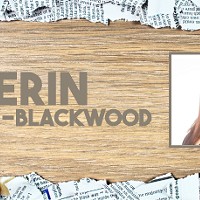
As Marijuana Hits the Mainstream, Black People Aren't Being Invited to the Party
May 23, 2020 -

Drive your favorite exotic cars flat out on real racetracks all across the US. Dreams can come true!
Mar 26, 2019 -
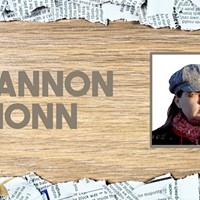
Industry Experts Discuss the 'Green Wave,' Social Barriers and Business Tips
Jul 25, 2018 - More »
Latest in Cover
More by Jarvis Holliday
Calendar
-
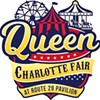
Queen Charlotte Fair @ Route 29 Pavilion
-
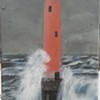
NEW WINDOW GALLERY-Pat Rhea-ACRYLIC PAINTINGS-April 05-30 2024 VALDESE, NC 28690 @ New Window Gallery/Play It Again Records
- Through April 30, 12 p.m.
-

TheDiscountCodes
-

Wine & Paint @ Blackfinn Ameripub- Ballantyne
-

Face to Face Foundation Gala @ The Revelry North End

